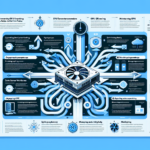As an IT manager responsible for a diverse IT infrastructure, including datacenters, storage, backup, servers, virtualization, operating systems (Windows/Linux), Kubernetes, AI workloads, and GPU-based systems, performance tuning is a critical task. Below are the best practices for optimizing IT infrastructure performance:
1. Datacenter Optimization
- Power and Cooling Efficiency: Ensure optimal airflow and cooling systems to prevent thermal throttling of hardware. Use hot/cold aisle configurations and monitor environmental conditions.
- Network Infrastructure: Use high-speed switches and routers, and ensure proper network segmentation to avoid bottlenecks. Implement VLANs and QoS for prioritized traffic.
- Physical Security and Maintenance: Regularly inspect hardware and cabling to prevent wear and tear.
2. Storage Performance
- Storage Tiering: Use tiered storage (SSD, NVMe, HDD) for different workloads. High-performance applications should use faster storage like NVMe.
- RAID Configuration: Implement RAID levels (RAID 10, RAID 5) for redundancy and performance balance.
- IOPS Optimization: Monitor Input/Output Operations Per Second (IOPS) to identify bottlenecks. Adjust caching and block sizes for specific workloads.
- Storage Network: Use high-speed protocols like NVMe over Fabrics (NVMe-oF) or Fibre Channel for SAN-based storage.
3. Backup and Recovery
- Incremental Backups: Use differential or incremental backups to reduce backup times and storage usage.
- Replication and Snapshots: Implement replication for critical workloads and snapshots for quick recovery.
- Test Recovery: Regularly test restore processes to ensure backup systems are functioning correctly.
- Backup Storage Optimization: Use deduplication and compression to reduce storage costs.
4. Server Performance
- Resource Allocation: Ensure adequate CPU, memory, and disk resources. Monitor server utilization and adjust workloads to prevent over-provisioning or underutilization.
- BIOS and Firmware Updates: Keep server BIOS, firmware, and drivers updated for optimal performance.
- Hardware Monitoring: Use tools to monitor server health (temperature, fan speeds, disk health) to proactively address issues.
5. Virtualization Best Practices
- VM Resource Allocation: Avoid overcommitting CPU, memory, and storage for virtual machines (VMs). Use reservation policies for critical workloads.
- Hypervisor Optimization: Ensure the hypervisor (e.g., VMware, Hyper-V) is updated and configured for performance.
- Storage for VMs: Use shared storage (e.g., SAN/NAS) for VMs to enable high availability and faster access.
- VM Placement: Use Distributed Resource Scheduler (DRS) to balance workloads across hosts dynamically.
6. Windows and Linux Performance
- Patch Management: Regularly apply updates and patches to operating systems to improve stability and security.
- Performance Monitoring: Use built-in tools like Windows Performance Monitor or Linux utilities like
top,iotop, andvmstatto identify bottlenecks. - Service Optimization: Disable unnecessary services to free up resources.
- Filesystem Tuning: Use appropriate filesystems (e.g., NTFS for Windows, EXT4/XFS for Linux) and configure mount options for performance.
7. Kubernetes Optimization
- Pod Resource Requests and Limits: Define resource requests and limits for pods to prevent noisy neighbors and ensure resource fairness.
- Node Autoscaling: Implement cluster autoscaling to scale nodes based on demand.
- Networking: Optimize CNI (Container Network Interface) plugins and use tools like Calico or Cilium for better networking performance.
- Persistent Storage: Use storage classes optimized for Kubernetes workloads (e.g., dynamic provisioning).
- Monitoring: Use tools like Prometheus and Grafana to monitor cluster health and performance.
8. AI Workloads and GPU Tuning
- GPU Utilization: Optimize GPU usage by monitoring workloads using tools like NVIDIA SMI or AMD ROCm. Ensure GPU memory and compute resources are efficiently utilized.
- CUDA or ROCm Optimization: Use libraries (e.g., CUDA for NVIDIA or ROCm for AMD) optimized for AI workloads.
- Parallelism: Optimize algorithms for parallel processing to fully utilize GPU cores.
- Driver and Firmware Updates: Keep GPU drivers and firmware updated to benefit from performance improvements.
- Batch Processing: Adjust batch sizes for AI workloads to optimize GPU throughput.
9. Network Infrastructure
- Latency Reduction: Use low-latency switches and configure MTU sizes appropriately (e.g., Jumbo Frames for storage networks).
- Bandwidth Management: Monitor bandwidth usage and implement traffic shaping to prioritize critical workloads.
- DNS Optimization: Use fast and reliable DNS servers. Consider caching DNS queries locally.
- Firewall Rules: Optimize firewall rules to minimize latency while maintaining security.
10. Monitoring and Automation
- Centralized Monitoring: Use tools like Nagios, Zabbix, SolarWinds, or Datadog for centralized monitoring of the infrastructure.
- Log Analysis: Aggregate logs from all systems using tools like ELK Stack (Elasticsearch, Logstash, Kibana) or Splunk for proactive issue detection.
- Automation: Use configuration management tools like Ansible, Puppet, or Chef to automate repetitive tasks and reduce human error.
11. Documentation and Training
- Standard Operating Procedures (SOPs): Maintain detailed documentation for all configurations and processes.
- Team Training: Keep your team updated on new technologies and best practices to ensure they can respond effectively to performance issues.
By following these best practices, you can ensure a high-performing and resilient IT infrastructure capable of meeting current and future demands. Regular audits and proactive tuning will help maintain optimal performance across all components.





